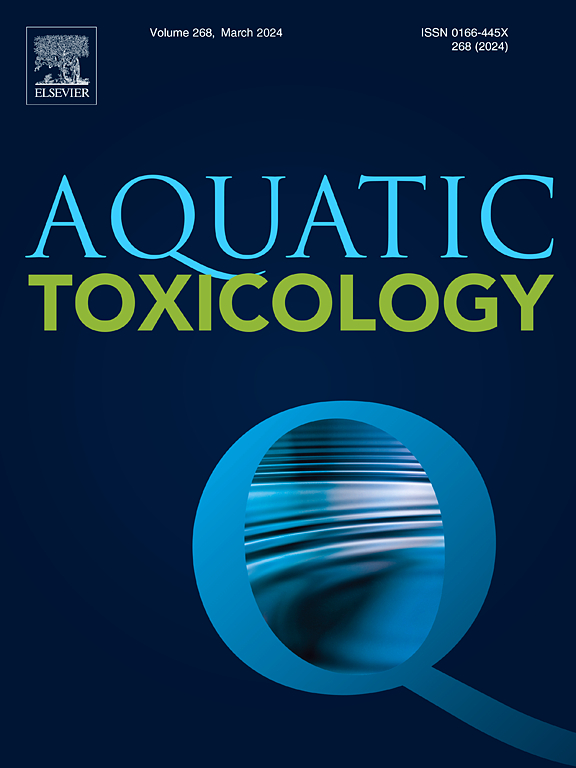Immunotoxicity of thyroid hormone system disrupting compounds in fish
IF 4.1
2区 环境科学与生态学
Q1 MARINE & FRESHWATER BIOLOGY
引用次数: 0
Abstract
Endocrine disrupting compounds (EDCs) are among the most studied environmental pollutants in the field of (eco)toxicology, and different fish species are commonly used as model organisms, especially for studying reprotoxic effects. Despite the scientific and regulatory importance of EDCs, little attention has been given to their immunotoxic effects in fish. Basic knowledge and test systems for immune-related outcomes in fish are limited. For example, while the impact of estrogenic EDCs on the fish immune system has raised some attention in the last decade, thyroid hormone system disrupting compounds (THSDCs) and their impact on the fish immune system are less well studied. Thus, this literature review is aimed at describing the immunomodulatory roles of thyroid hormones (THs), as well as summarizing the existing research on the immunotoxicity of THSDCs in fish. A simplified potential adverse outcome pathway (AOP) was created, explaining the key events between THSD and lowered survival of fish experiencing pathogen infections along with chemical exposure. This AOP demonstrates that THSDCs can alter immune system functioning on a molecular, cellular, and organism level and, therefore, lead to reduced survival by lowering pathogen resistance of fish. However, available data were mainly limited to molecular analyses of immune-related biomarkers and included only few studies that conducted experiments demonstrating immunotoxic effects at organism level that can inform about population-relevant outcomes. Our putatively developed and simplified AOP can support the incorporation of immune-related endpoints in EDC testing guidelines and aid the development of risk assessments for THSDCs for human and environmental health.
甲状腺激素系统干扰物对鱼类的免疫毒性
内分泌干扰化合物(EDCs)是生态毒理学领域研究最多的环境污染物之一,不同的鱼类通常被用作模式生物,特别是用于研究生殖毒性效应。尽管EDCs在科学和监管方面具有重要意义,但很少有人关注它们对鱼类的免疫毒性作用。鱼类免疫相关结果的基本知识和测试系统有限。例如,虽然雌激素EDCs对鱼类免疫系统的影响在过去十年中引起了一些关注,但甲状腺激素系统干扰化合物(THSDCs)及其对鱼类免疫系统的影响研究较少。因此,本综述旨在描述甲状腺激素(THs)的免疫调节作用,并对THSDCs对鱼类免疫毒性的现有研究进行综述。建立了一个简化的潜在不良结果通路(AOP),解释了THSD与经历病原体感染和化学暴露的鱼类存活率降低之间的关键事件。该AOP表明,THSDCs可以在分子、细胞和有机体水平上改变免疫系统功能,因此,通过降低鱼类的病原体抗性来降低存活率。然而,现有的数据主要局限于免疫相关生物标志物的分子分析,并且只有少数研究进行了实验,证明了在生物体水平上的免疫毒性作用,可以为人群相关的结果提供信息。我们假设开发和简化的AOP可以支持将免疫相关终点纳入EDC检测指南,并有助于制定THSDCs对人类和环境健康的风险评估。
本文章由计算机程序翻译,如有差异,请以英文原文为准。
求助全文
约1分钟内获得全文
求助全文
来源期刊

Aquatic Toxicology
环境科学-毒理学
CiteScore
7.10
自引率
4.40%
发文量
250
审稿时长
56 days
期刊介绍:
Aquatic Toxicology publishes significant contributions that increase the understanding of the impact of harmful substances (including natural and synthetic chemicals) on aquatic organisms and ecosystems.
Aquatic Toxicology considers both laboratory and field studies with a focus on marine/ freshwater environments. We strive to attract high quality original scientific papers, critical reviews and expert opinion papers in the following areas: Effects of harmful substances on molecular, cellular, sub-organismal, organismal, population, community, and ecosystem level; Toxic Mechanisms; Genetic disturbances, transgenerational effects, behavioral and adaptive responses; Impacts of harmful substances on structure, function of and services provided by aquatic ecosystems; Mixture toxicity assessment; Statistical approaches to predict exposure to and hazards of contaminants
The journal also considers manuscripts in other areas, such as the development of innovative concepts, approaches, and methodologies, which promote the wider application of toxicological datasets to the protection of aquatic environments and inform ecological risk assessments and decision making by relevant authorities.
 求助内容:
求助内容: 应助结果提醒方式:
应助结果提醒方式:


